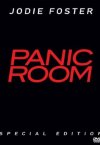BUY THE DVD:
|


|
|
|
SYNOPSIS:
| |
three men search for a missing fortune in a big mansion while a woman hides in one of its rooms.
|
|
|
MOVIE FACT:
| |
nicole kidman was once to have starred in this film, but had to drop out because of a knee injury.
|
|
|
RATING:
|


two out of four possible stars
|
|
|
|
Right off the bat, Panic Room presents itself as a film whose roots could have easily come from a stage play. But the restricted locations don't necessarily mean that the film itself is limited. Though this movie's accomplishment stems more from its cast than either the location or the script. Located in a ridiculously large brownstone apartment building in Manhattan, Panic follows the efforts of one woman to eject a trio of thieves from her home to save herself and her diabetic daughter. She uses a state-of-the-art "Panic Room" to hide from the thieves, not knowing that what they want to steal is inside that room.
So for the next couple of hours, Jodie Foster must think up a few ingenious plots to thwart the thieves. There is a suitable amount of twists at the turning points of the film and though the script itself isn't completely original (concerning dialogue, anyway), each actor gives the film value. After an absence from the screen of about two years, Foster proves that she can carry the weight of an action-oriented film yet still manage to inject a certain amount of intelligence and humor into her character. And speaking of funny stuff, Panic Room has a surprising amount of humorous situations and these light moments really work to liven up the heavy atmosphere.
More than two-thirds of the film takes place in low light and since the story deals with burglary, murder, and mean stuff in general, the comedy works two-fold. It makes the film not so depressing (which much of it is) and it makes the serious moments more effective. Humorless action films can easily get bogged down in mindless combat. But since Panic Room is so dependent on the twists and turns presented by its screenwriter, the nearly predictable last act causes this film to fall short just a few yards shy of the finish line. There are two main reasons for this shortcoming: the first act and the third act. Hollywood films are put together in three acts, with the first and third being of equal length and the second running twice as long.
This film starts off slow (in the first act) and loses some of its intensity by the end (in the third act). What is ironic about each part of this film, is that the second act is the best. This is strange, given that screenwriters typically have a stunning first act, a slower second act, and a frenetic third act. But the first thirty or so minutes of the film really move at a pace slightly faster than a snail. And the cinematography of this slow, dream-like pace adds to the whole feeling that Jodie Foster's character is asleep for the first half-hour or so. The camera moves are very fluid and a whole lotta steadicam work was used. In fact, the cinematography calls a lot of attention to itself from a series of long running camera moves that take the viewer through such objects as the slats in the staircase, the handle of a coffeepot, and the back of a chair.
So much attention is placed on the way the camera moves that when the film transitions into the second act, it is very noticeable when those smooth moves disappear. The filmmakers were probably aiming for an increase in pace with the change in composition over the course of the film. Whatever their reasoning, they actually broke one of the cardinal rules of cinematography: impress without being noticed. But this aspect of the film is probably something that helps the film, allowing the mild tone of the beginning to the fast paced middle.
Cinematography aside, this film still trips up at the end. a film can bear only so much screen-time devoted to one string of action, and by the third act, much of what can be said and shown about the panic room and its inhabitants has been put on the screen. And the fact that all of the characters in this film are easy to read, makes it fairly easy to predict their outcomes. The surprises in the third act really aren't that surprising. The characters give the audience too much of clue as to their true motives (and this goes for every character) that what they do in the end is all too predictable.
But given this film's faults, most of which relate to the screenplay and how the story is presented, the performances in this film rate higher than usual action film fare. Jodie Foster and the young girl who plays her daughter in the film, Kristen Stewart, play their parts better than should be expected, as do the rest of the supporting cast. Forrest Whitakar, Dwight Yoakam, and Jared Leto give their bad-guy characters enough juice to ensure that audience members interested in an entertaining time at the movies will not be disappointed. But those looking for a smart and insightful thriller, which, by definition a thriller is expected to be, might have to lower their expectations somewhat.
Review by Kelsey Wyatt.
| |
|